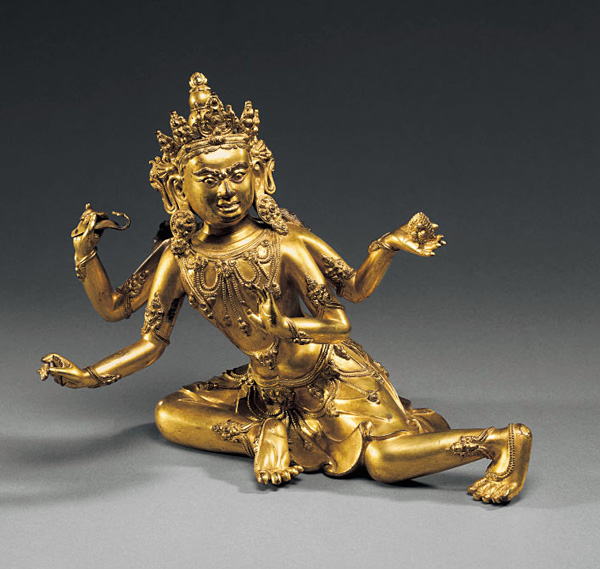|

Vajrabhairava is an emanation of yamantaka, one of the eight defenders of the Buddhist law. He is known with nine heads, thirty-four arms, and sixteen legs. This black and naked deity steps to the right on animals, birds, demons and Hindu deities. The centre head is a bull's. This important god has a ferocious aspect in order to instill fear into evil spirits or sinners. The present sculpture is one of the four principle deities placed on the throne in front of a gigantic and highly important sculpture of Vajrabhairava; an imperial commission of the Yongle or Xuande reign.
Another example which originally belonged to the same group was in the Beasly collection, England and Philip Goldman collection, London and is published in Ulrich von Schroeder Indo-Tibetan bronzes, Hong Kong 1981, nr. 146 A, page 520. A third known example was sold in England in 1985 at Sothebys, June sale lot nr. 218.
Portrayed in a reclining pose the deity is depicted with four arms. His left foot is balancing his body weight and is stretched on the flat ground beneath him. In his raised left hand he holds the Triratna, the three jewels, symbolising Buddha, Dharma (law) and Sangha (community). His head is raised slightly and turns to the left. The attendant is wearing beaded jewellery around his waist, a richly decorated girdle-ornamentation upon his lower dress and is adorned with necklaces, bracelets, circular ear ornaments and anklets. He wears a five leaf crown on his head with ornaments fluttering above and alongside his ears. Long plaits of hair fall onto his shoulders, his other hair being tied up in a high chignon and topped by a lotus bud. Striking are the unusually shaped eyebrows and the urna, the sign of illumination, both placed on his forehead.
After Taizu, the Hongwu emperor (1368-1398 A.D.) restored diplomatic and trade missions with Tibet, the Chinese emperor Chenzu sought actively the services of Tibetan lamas in the Yongle era (1403-1424 A.D.). Of the outstanding bronze sculptures from this period, many bear the Imperial inscriptions of the Yongle and Xuande (1426-1435) periods. They were produced in government workshops, and may be regarded as classic examples of the Tibeto-Chinese style. This bronze attendant to Vajrabhairava is a great example of this period, an early Ming work of art, produced in the first half of the 15th century, exhibiting all the typical stylistic characteristics; the exquisite modelling, the superb fine gilding, the shape of the five leaf crown, the typical moving ornamentations and the style of the jewellery.
This unique and inspired composition reveals a great freedom of artistic imagination. The powerful posture of the deity is enhanced by striking movements, creating a sense of dynamic force, and is mesmerising from all angles. The bronze is suberbly cast comprising finely articulated features, perfect natural volumes, superb balance and beautiful gilding which complements the lively presence of the deity. The bronze an extremely rare and important example of its period; it is one of only three examples which are known of similar date, size and craftsmanship.
Provenance: Formerly in the collection of Mrs. Shears, Mulberry tree Hall, Brook Thorpe, Gloucestershire, England.
|

